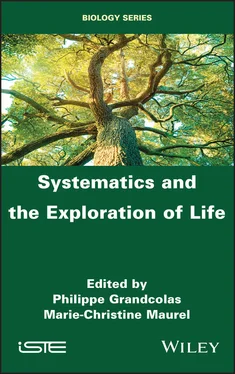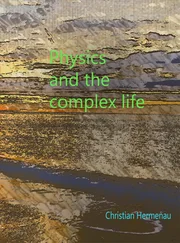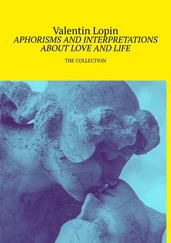Systematics and the Exploration of Life
Здесь есть возможность читать онлайн «Systematics and the Exploration of Life» — ознакомительный отрывок электронной книги совершенно бесплатно, а после прочтения отрывка купить полную версию. В некоторых случаях можно слушать аудио, скачать через торрент в формате fb2 и присутствует краткое содержание. Жанр: unrecognised, на английском языке. Описание произведения, (предисловие) а так же отзывы посетителей доступны на портале библиотеки ЛибКат.
- Название:Systematics and the Exploration of Life
- Автор:
- Жанр:
- Год:неизвестен
- ISBN:нет данных
- Рейтинг книги:3 / 5. Голосов: 1
-
Избранное:Добавить в избранное
- Отзывы:
-
Ваша оценка:
- 60
- 1
- 2
- 3
- 4
- 5
Systematics and the Exploration of Life: краткое содержание, описание и аннотация
Предлагаем к чтению аннотацию, описание, краткое содержание или предисловие (зависит от того, что написал сам автор книги «Systematics and the Exploration of Life»). Если вы не нашли необходимую информацию о книге — напишите в комментариях, мы постараемся отыскать её.
Systematics and the Exploration of Life — читать онлайн ознакомительный отрывок
Ниже представлен текст книги, разбитый по страницам. Система сохранения места последней прочитанной страницы, позволяет с удобством читать онлайн бесплатно книгу «Systematics and the Exploration of Life», без необходимости каждый раз заново искать на чём Вы остановились. Поставьте закладку, и сможете в любой момент перейти на страницу, на которой закончили чтение.
Интервал:
Закладка:
Table of Contents
1 Cover
2 Title Page Series Editor Marie-Christine Maurel
3 Copyright First published 2021 in Great Britain and the United States by ISTE Ltd and John Wiley & Sons, Inc. Apart from any fair dealing for the purposes of research or private study, or criticism or review, as permitted under the Copyright, Designs and Patents Act 1988, this publication may only be reproduced, stored or transmitted, in any form or by any means, with the prior permission in writing of the publishers, or in the case of reprographic reproduction in accordance with the terms and licenses issued by the CLA. Enquiries concerning reproduction outside these terms should be sent to the publishers at the undermentioned address: ISTE Ltd 27-37 St George’s Road London SW19 4EU UK www.iste.co.uk John Wiley & Sons, Inc. 111 River Street Hoboken, NJ 07030 USA www.wiley.com © ISTE Ltd 2021 The rights of Philippe Grandcolas and Marie-Christine Maurel to be identified as the author of this work have been asserted by them in accordance with the Copyright, Designs and Patents Act 1988. Library of Congress Control Number: 2020949898 British Library Cataloguing-in-Publication Data A CIP record for this book is available from the British Library ISBN 978-1-78630-265-6
4 Introduction
5 1 Symmetry of Shapes in Biology: from D’Arcy Thompson to Morphometrics1.1. Introduction 1.2. D’Arcy Thompson, symmetry and morphometrics 1.3. Isometries and symmetry groups 1.4. Biological asymmetries 1.5. Principles of geometric morphometrics 1.6. The treatment of symmetry in morphometrics 1.7. Some examples of applications 1.8. Conclusion 1.9. References
6 2 Impact of a Point Mutation in a Protein Structure2.1. Composition 2.2. Folding 2.3. Substitution(s) in protein structures 2.4. Effect on overall structure and function 2.5. Effect on stability 2.6. Effect on the peptide backbone 2.7. Conclusion 2.8. References
7 3 The Role of Taxonomy and Natural History in the Study of the Evolution of Eneopterinae Crickets 3.1. Introduction 3.2. Taxonomy in modern comparative approaches 3.3. A model group 3.4. Contribution of taxonomy for phylogenetic reconstructions and classification 3.5. Contribution of taxonomy to biogeography 3.6. Taxonomic exploration and evolution of species traits 3.7. Conclusion 3.8. Acknowledgments 3.9. References
8 4 Systematics in the (Post)genomic Era: A Look at the Drosophila Model 4.1. Drosophila: a star of genetics but a systematic nebula 4.2. Subspecies: identification of “genomic islands of divergence”? 4.3. Species complexes: congruence between species trees and gene trees 4.4. Supraspecific ranks: phylogeny, genome and morphome 4.5. Conclusion 4.6. Acknowledgments 4.7. References
9 5 Dealing with Multiple Environments: The Challenges of the Trypanosome Lifecycle5.1. Human African trypanosomiasis, the disease 5.2. Cell biology of Trypanosoma brucei 5.3. Survival and maturation of T. brucei in the tsetse vector 5.4. Adaptations of T. brucei to the mammalian host 5.5. Conclusion 5.6. References
10 6 Challenges Inherent in the Systematics and Taxonomy of Genera that have Recently Experienced Explosive Radiation: The Case of Orchids of the Genus Ophrys 6.1. Introduction 6.2. Speciation in Ophrys: an evolutionary divergence seen as a reticulated continuum 6.3. Current state of knowledge on Ophrys systematics 6.4. Integrative genomics and taxonomy: perspectives and issues 6.5. Conclusion 6.6. Acknowledgments 6.7. References
11 7 Exploration and Origins of Biodiversity in Madagascar: The Message of Ferns7.1. Introduction 7.2. Madagascar: a complex biogeographical context 7.3. Ferns and lycophytes: an ideal model for the biogeography of Madagascar 7.4. Origins of the lineages of ferns in Madagascar 7.5. The example of Rumohra: dispersions to Madagascar and around the world 7.6. Conclusion 7.7. References
12 8 Mediterranean and Atlantic Algae, a Fraternal Relationship? 8.1. Introduction 8.2. Materials and methods 8.3. Results 8.4. Discussion 8.5. Acknowledgments 8.6. References
13 9 Ontogeny and Evolution of the Hyperorgan of Delphinieae 9.1. Introduction 9.2. Synorganization: a concept, definitions 9.3. Ontogeny and evolution of the hyperorgan of Delphinieae 9.4. The study of synorganization in evolutionary biology 9.5. Conclusion 9.6. Acknowledgments 9.7. References
14 10 Identification of Interspecific Chromosomal Homologies: Chromosomal Microdissection and Chromosomal Painting in Antarctic Teleosts Nototheniidae10.1. Introduction 10.2. Materials and methods 10.3. Results 10.4. Discussion 10.5. Conclusion 10.6. References
15 List of Authors
16 Index
17 Other titles from ISTE in Biology and Biomedical Engineering
18 End User License Agreement
List of Tables
1 Chapter 8Table 8.1. List and collection information of the specimens included in our stud...
2 Chapter 9Table 9.1. Botanical research articles, whose title includes the term synorganis...
3 Chapter 10Table 10.1. Taxonomic sampling for chromosome suspensionsTable 10.2. Quantification of the different steps after amplifications and purif...
List of Illustrations
1 Chapter 1 Figure 1.1. Diversity of symmetric patterns in the living world. For a color ver... Figure 1.2. Principles of geometric morphometrics illustrated for the simple cas... Figure 1.3. Morphometric analysis of matching symmetry. For a color version of t... Figure 1.4. Morphometric analysis of object symmetry. For a color version of thi... Figure 1.5. Morphometric analysis of object symmetry and partition of the symmet...
2 Chapter 2 Figure 2.1. a) General structure of an amino acid; b) chemical formula of leucin... Figure 2.2. A polypeptide consisting of four amino acids (tetrapeptide) Figure 2.3. a) DNA binding protein of Drosophila melanogaster (PDB code 1enh); b... Figure 2.4. a) Superimposed structures of the D67H mutant (green, PDB code 1lyy)... Figure 2.5. Comparison of predicted ΔΔG by FoldX and those experimentally measur... Figure 2.6. Procedure for calculating “local” RMSDs. For a color version of this... Figure 2.7. RMSD calculated for 78 mutants of a transferase, the reference being... Figure 2.8. Distribution of RMSD, p-values and p-ranks. For a color version of t...
3 Chapter 3 Figure 3.1. Phenotypic diversity of Eneopterinae crickets. For a color version o...Figure 3.2. Phylogenetic relationships of species of the Eneopterinae subfamily,...Figure 3.3. Schematic representation of the geographical situation of New Caledo...Figure 3.4(A). Schematic representation of the distribution areas of Cardiodacty...Figure 3.4(B). Schematic representation of the distribution areas of Cardiodacty...Figure 3.5. Cricket intraspecific communication systems. For a color version of ...
4 Chapter 4Figure 4.1. The continuum of ecological speciation. a) Evolution of reproductive...Figure 4.2. Recurrent specialization by Drosophila on toxic nono fruits (Morinda...Figure 4.3. ABBA-BABA genomic test, demonstrating different possible scenarios o...Figure 4.4. Complex history of the evolution of the allele of the abdominal pigm...Figure 4.5. Coevolution between male (blue, green and red) and female (yellow an...
5 Chapter 5Figure 5.1. Electron microscopy images of the nucleus (left) and kinetoplast (ri...Figure 5.2. Representation of a Glossina morsitans morsitans tsetse fly. A) Draw...Figure 5.3. Morphological changes in trypanosomes during the development in the ...Figure 5.4. Morphology of the main bloodstream form trypanosomes: proliferative ...Figure 5.5. VSG expression dynamics through T. brucei infection in mice. Each co...Figure 5.6. Skin parasites in experimental in vivo infections. T. brucei parasit...
6 Chapter 6Figure 6.1. Summary of the different speciation processes known in the genus Oph...Figure 6.2. Speciation in a context of reticulated evolutionFigure 6.3. Most likely topology to represent the phylogenetic relationships bet...
Читать дальшеИнтервал:
Закладка:
Похожие книги на «Systematics and the Exploration of Life»
Представляем Вашему вниманию похожие книги на «Systematics and the Exploration of Life» списком для выбора. Мы отобрали схожую по названию и смыслу литературу в надежде предоставить читателям больше вариантов отыскать новые, интересные, ещё непрочитанные произведения.
Обсуждение, отзывы о книге «Systematics and the Exploration of Life» и просто собственные мнения читателей. Оставьте ваши комментарии, напишите, что Вы думаете о произведении, его смысле или главных героях. Укажите что конкретно понравилось, а что нет, и почему Вы так считаете.












